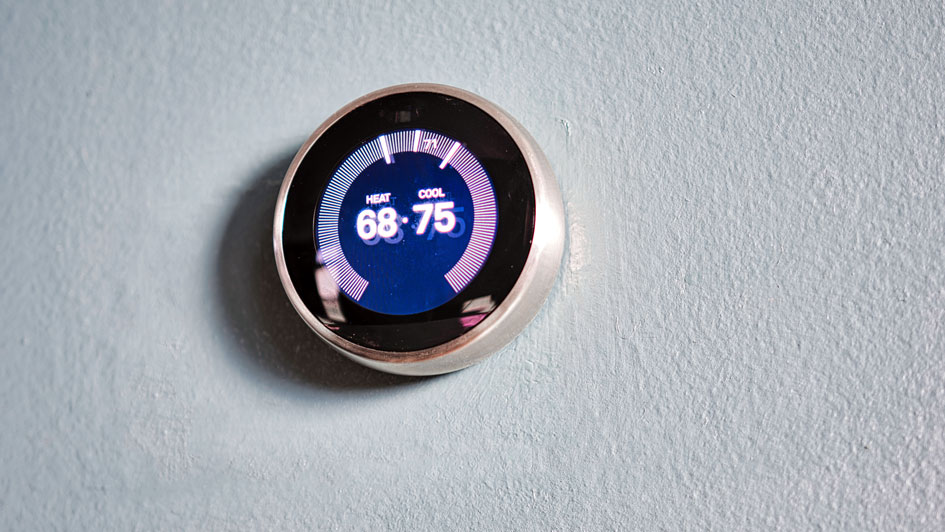
A Nest Thermostat is an excellent tool for keeping your home comfortable, regardless of the season or weather. With a range of features and programs designed for maximum efficiency, convenience and comfort, a Nest Thermostat is an easy way to manage your energy use — keeping costs down in the process.
That’s why more people are looking to add devices like a Nest to their HVAC system. To add one to your home, call your nearest expert for smart thermostat installation in Auburn.
With everything from automatic scheduling to optimizing energy efficiency, Nest is designed to make securing your sense of comfort effortless.
Want all the details? Take some time to review these 12 things you need to know about your Nest Thermostat.
1. Resetting Your Nest Thermostat
One of the first things to know about resetting a Google Nest Thermostat is that resetting is different from restarting.
- Restart: Similar to restarting any electronic device, including your phone or computer, restarting your Nest Thermostat means a quick off / on cycle. This records your existing thermostat settings, ad can reapply them once you're done confirming if your Nest is frozen or not connecting to Wi-Fi.
- Reset: Conversely, resetting eliminates most if not all of your preferred settings. In most cases, people resort to a reset when they’re moving to a new home and bringing the thermostat with them, or if they are moving out and want to erase any personal details from the Nest before leaving it behind for the next resident.
If you want to perform a reset, it helps to record existing temperature settings so you have them if they get erased. Next, go to Settings -> Equipment and record your system wires, heating type and safety temperature settings.
Then, to manually restart or reset your Nest, go to Settings, select Reset and press. You can choose from five options:
- Restart: Deactivates your Nest and starts it back up while remembering your settings. Another way to restart is to press the outside of the Nest and hold it down for a few seconds until it goes black, and then pull your hand away.
- Schedule: This reset setting clears all scheduling information—including for your hot water, if that has been connected to your Nest. With this option, you’ll need to create a new schedule or wait while your Nest learns your schedule.
- Away: An Away reset removes anything your Nest has learned about how often you walk by, so that it can change the temperature accordingly.
- Network: With a network reset, it will remove all your network information and your Nest can no longer connect to Wi-Fi. It also forgets your Wi-Fi password.
- All Settings: The most far-reaching option, using the All Settings reset option clears all your personal settings and learning.
2. How to Connect Nest Thermostat to Wi-Fi
Connecting to Wi-Fi is important for making the most of your Nest's features.
To connect your Nest to the internet:
- Turn the thermostat ring to the Quick View menu.
- Select the Settings icon.
- Press Network.
- Once your Nest has scanned nearby networks, select your Wi-Fi and, if necessary, put in your password.
3. Does a Nest Thermostat Have a Battery and How Long Does It Last?
Nest thermostats receive power from your HVAC system, but also have a rechargeable lithium-ion battery for backup in case of a power outage. According to Google, the maker of Nest, a Nest Thermostat battery will generally last several months. It can be recharged using a USB charger that comes with the Nest.
4. Shutting Off a Nest Thermostat
If you plan on being away for a couple weeks, consider setting your Nest Thermostat to Off mode, though Eco mode would be another option. Off mode shuts down all your regular heating and cooling schedules, but it will still adhere to any current Safety Temperatures to keep your home from getting dangerously hot or cold.
To choose Off mode on the thermostat:
- Press and hold the touch bar until it displays “Turn Off” and then slide the bar to highlight Turn Off, and then touch the bar to select.
- Or, from the main menu, go to Mode and select Off.
Off mode is available on the Google Home app as well:
- Select Thermostat from home screen
- Tap Temperature mode
- Select Off
5. Can Alexa Control a Nest Thermostat?
Yes, you can use Amazon Alexa to control a Nest Thermostat. Alexa can also be integrated with with Nest doorbells and cameras. You can even operate a Nest Thermostat with Google Assistant.
6. Does a Nest Thermostat Work Without Wi-Fi?
The good news is that a Nest Thermostat will still be able to adjust the temperatures without Wi-Fi. However, a lack of an internet connection means your Nest doesn’t have access to all the key features that most people enjoy.
7. Can You Lock a Nest Thermostat?
When family members can't stop bickering over temperatures, Nest has a function to give you the upper hand.
Nest has a locking feature that allows a user to stop any temperature adjustments outside of a preset range. This doesn't mean you're stuck with a single temperature—a locked Nest continues to use existing program settings—but simply prevents people from changing the settings.
If you want to lock your Nest:
- Select the Settings icon, scroll to the bottom and find Lock.
- Enter a 4-digit pin number you can remember, and then enter it twice.
- For locking a Nest in Heat or Cool mode, fine-tune your maximum and minimum temperature range and then press Lock at the bottom of the screen.
To unlock a Nest, open the settings and choose Unlock. Once you enter your 4-digit pin, your device will be unlocked.
8. How to Control a Nest Thermostat from Your Phone
You can control the Nest through your Google Home app, accessible through your phone or desktop computer. Other versions of Nest, including the Nest Thermostat E and Nest Learning Thermostat, can also be controlled remotely by the Nest app.
Before you can make adjustments for a Nest on your phone with Google Home or the Nest app, there are a few steps to complete first:
- Download the Google Home app or, with premium Nest models, the Nest app to your phone.
- Connect your Nest Thermostat.
- Open the Google Home app on your phone and select the account, link to your new device and connect to Wi-Fi.
- There is a guided setup tool on Google, for those needing extra assistance in connecting.
After you've added the Nest to your Home app, you can find and adjust it by clicking Thermostat on the home screen. Once you do that, you can make changes to the temperature by dragging your finger along the screen or tapping on a plus or minus sign.
You also can change preset Nest temperatures on the app. From the home screen, find your Thermostat and then select Settings. At this screen, select Temperature Preferences and then Temperature Presets. The display will show your preferred Comfort, Eco and Sleep temperatures. Select one of these options to change the temperature for that preset.
9. Setting a Nest Thermostat Schedule
Your Nest allows you to schedule temperature programming either on the device or on the Google Home app. More advanced versions of the Nest, such as the Nest Thermostat E and Nest Learning Thermostat, can also be adjusted by using the Nest app.
There are two ways you can set up a schedule on your Nest:
- Quick Schedule: A Quick Schedule will be based on the national average schedule for energy efficiency. As you complete your Nest's setup process, the Google Home app allows you to change the temperature with a schedule. When choosing this option, it displays a preset schedule before letting you customize it. Once setup is complete, that’s the schedule it uses.
- Temperature Presets: To change the temperature presets on your Nest, open the Google Home app and select Thermostat. Then, tap Presets and select Edit. Once you’ve made the changes, select Done.
To make tweaks or changes to your current schedule, open the Google Home app, select Thermostat and then tap on Schedules. Choose the day of the week where you want to make changes. Once you pick the day, tap Add and select the preset you want. Finally, select Time before touching and dragging the numbers to change the time. Your update won't be applied until you select Done.
10. Setting a Temperature Range on a Nest Thermostat
Your Nest's Eco mode is great for setting temperature ranges. This is a function that adjusts the temperature in your home depending on if anyone is in the residence or if it is empty.
To create a custom temperature range in Eco mode, go to Settings and select Eco. That should display the current “Heat to” and “Cool to” temperature settings. You can select each and make any and all adjustments. Once you're finished, select Done.
11. What Should I Do If My Nest Thermostat Isn't Compatible?
A Nest Thermostat is compatible with most heating and cooling systems. The maker of Nest, Google, has an online compatibility checker that asks a series of questions about your location and existing setup to see which Nest model is compatible with your system.
If you don't think your Nest is compatible with your system, you should get in touch with local pros for smart thermostat installation in Auburn. Experienced technicians evaluate your system and, if your Nest is compatible, get it installed and on the road to saving you money in no time.
12. How Do I Manually Control My Nest Thermostat?
Nest Thermostats come with many features designed to make life more comfortable and save money. However, you have the ability to turn off the smart features if you prefer to control your Nest like it's a normal thermostat.
Remember, by doing this you're eliminating your temperature schedules and your Nest will work like any other thermostat—it will display the temperature and allow you to make changes, but that’s about it.
Setting your thermostat to manual controls can be accomplished with the following steps:
- Auto-Schedule: From the main screen, go to Settings and then scroll to Nest Sense. Go to Auto-Schedule, select No and click Done.
- Eco: From the main screen, go to Settings, scroll to Eco. Once in Eco, select Off for both the current Heat to and Cool to temperatures, and select Done.
- Home/Away Assist: From the main screen, go to Settings and select Home/Away Assist. Then, select Stop Using and click Done.
- Reset: After you've cleared the settings, reset your nest. From the main screen, go to Settings and select Reset, highlight Schedule and then select Reset to clear out any saved scheduling data.



